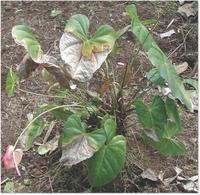Comparative and collaborative studies for the validation
A. Chabirand, E. Jouen, O. Pruvost, F. Chiroleu, B. Hostachy, M. Bergsma-Vlami, G. Bianchi, L. Cozzolino, J. Elphinstone, M. Holeva, F. Manole, P. Martini, H. Matous ková, J. Minatchy, G. Op de Beeck, F. Poliakoff, L. Sigillo, F. Siverio, J. Van Vaerenbergh, M. Laurentie and I. Robene-Soustrade.2014. Comparative and collaborative studies for the validation of a nested PCR for the detection of Xanthomonas axonopodis pv. dieffenbachiae from Anthurium samples. Plant Pathology, 63 (1) : 20-30.
Abstract
Efficient control of Xanthomonas axonopodis pv. dieffenbachiae, the causal agent of anthurium bacterial blight, requires sensitive and reliable diagnostic tools. The European standard EN ISO 16140:2003 has been followed to compare a nested PCR assay (N-PCR) to a reference method (isolation and serological identification of bacterial colonies) and to other alternative serological detection methods. The evaluation was performed in two steps: a comparative study and a collaborative study involving 15 European laboratories. Although inclusivity was maximal (100%) for all methods, a maximal exclusivity was obtained only with N-PCR followed by an enzymatic restriction digestion of the amplicons. Exclusivity indices of 906, 887 and 472% were found for indirect ELISA, immunofluorescence and double antibody sandwich ELISA, respectively. An exclusivity of 925% was obtained with the reference method, further increased to 100% if pathogenicity tests were performed as a supplemental assay. The best level of sensitivity (relative detection level) was obtained with the reference method followed by the N-PCR assay. The N-PCR performance in terms of relative accuracy, accordance and concordance was very similar to that of the reference method. Moreover, N-PCR had undeniable advantages compared to the reference method (less labour-intensive and less time-consuming). In addition, post-test probabilities of infection were calculated to select the most appropriate detection scheme related to the prevalence of the pathogen. The N-PCR assay has since been included in a revised version of the EPPO detection protocol.
Publiée : 10/02/2014
